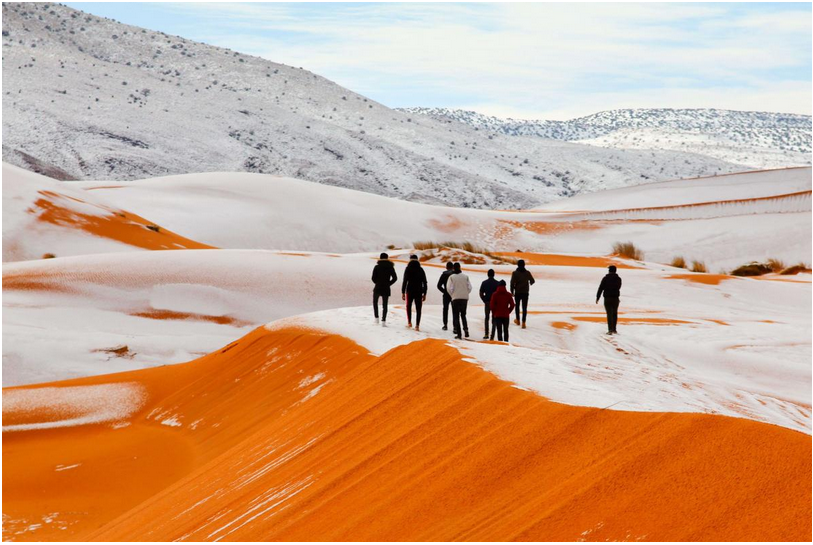Snowfall in the Sahara Desert: an unusual weather phenomenon - Top Destinations in Algeria

Snowfall in a hot desert may seem like a contradiction, but snow has been recorded many times in the Sahara Desert over the past few decades, most recently in January 2022. So snowfall may be unusual but not are not unprecedented in the region.
Researcher Jasper Knight of the University of the Witwatersrand explains in The Conversation that when snow forms, two distinct meteorological properties are needed: cold temperatures and moist air. The presence of snow reflects a particular combination of air circulation in the atmosphere and the nature of the earth's surface on which the snow falls.

Credit: Karim Bouchetata
Although the Sahara commonly experiences very high temperatures (over 50°C), low temperatures are also recorded (especially at night) due to the bare land surface and cloudless sky. A maximum cold of -14°C was recorded in Algeria in January 2005 during the northern hemisphere winter.
The Sahara is the largest hot desert in the world. It spans 11 North African countries: Algeria, Chad, Egypt, Libya, Mali, Mauritania, Morocco, Niger, Western Sahara, Sudan and Tunisia. It is bordered by the Atlantic Ocean to the west, the Red Sea to the east, the Mediterranean Sea to the north and the Sahelian savannah to the south.
Winter air circulation patterns draw cool, moist air north of the Sahara from the Atlantic and Mediterranean. This results in higher winter rainfall along the Saharan fringe in this season.
Over higher ground – such as the Atlas Mountains in Morocco and Algeria – rising air can cool, condense and, if the air is cold enough, its moisture can freeze to form snow crystals, then, possibly, a blanket of snow. If the land surface is also cold, the snow may linger and not melt immediately.
It is in these climatic conditions, and in these mountainous areas, that snow is sometimes found in the Sahara.
Saharan rainfall and snowfall

Credit: Karim Bouchetata
The center of the Sahara is hyperarid, receiving less than 100 mm of precipitation per year, but it also has bodies of water on three of its four sides. Humid air enters the region from the Atlantic Ocean, the Mediterranean Sea and the Indian Ocean, through low-pressure cyclones in the northern Sahara in winter and monsoon rains in the southern Sahara in summer. The peripheries of the desert are therefore more humid than its center. This means that snow is more likely to form on the outskirts of the desert.
The Atlas Mountains, in particular, act as a snow trap due to their proximity to the Atlantic and their altitude. The Algerian city of Ain Sefra received snowfall in the Northern Hemisphere winters of 1979, 2016, 2017, 2018, 2021 and 2022. This latest event was only a light dusting, turning the dunes of sand with a fine white coat, while in 2018 for example up to 30 cm of snow fell in the higher altitude areas. Several ski resorts are in the Atlas Mountains (mostly with artificial snow though) as evidence shows that snow falls relatively frequently here.
The Sahara and climate change

Aïn Sefra, snow at the gates of the Sahara in Algeria
Is snow in the Sahara becoming more or less common? The short answer is that we don't know yet. This is partly because of the lack of data on past events, but also because the climate modeling effort has not focused on the Sahara, a sparsely populated area.
A key property of the Sahara is its size (9 million km2) and its remoteness. This means that satellite remote sensing methods rather than ground observations are now used to map the timing, amount and distribution of precipitation and snowfall. But that only extends to the last few decades: there is very little evidence of snowfall patterns before satellite records became available in the 1970s.
Thus, Saharan snowfalls may historically be more frequent than we realize. It would be interesting to use anthropological evidence and oral histories to explore this possibility.
Globally, however, climate change is leading to more unpredictable weather patterns. In the Sahara, this may mean increased rainfall variability along its wetter Sahelian fringe and along the Atlantic and Mediterranean coasts (including the Atlas Mountains).

Credit: Karim Bouchetata
Snowfalls will likely continue – and could become more variable in timing and amount – if colder conditions on the mountains persist.
Although snow patterns are uncertain, this is not the main challenge facing the Sahara in the face of climate change. It is expected that the land side of the mountains will become drier and the central Sahara will remain dry and become even hotter. Increased drought, unsustainable pumping and pollution of underground aquifers mean there is less water available for its growing agriculture and cities.
In recent decades, the Sahara itself has also expanded due to the drying up of the southern Sahel and its transformation into a desert, and this is expected to continue in the decades to come.
Source: websites

